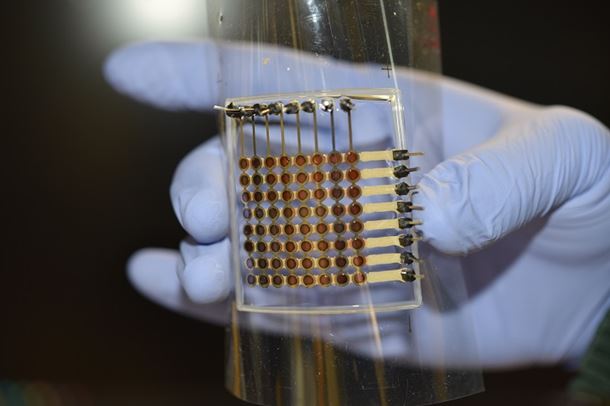“The OLED displays were realized entirely on a ‘one-pot’ 3D printing platform in the lab...within a few hours”Sung Hyun Park
The customized 3D printing of a flexible organic light-emitting diode (OLED) display has been developed by a team from the University of Minnesota Twin Cities in the United States. Their breakthrough, which is based on the conversion of electricity into light using an organic material layer, could lead to inexpensive OLED displays for handheld or wearable electronics made at home using 3D printers.
OLEDs function as high-quality digital displays that can be produced in a flexible way and used in a range of devices, from television screens and monitors to the ubiquitous smartphone. While these displays have become more widely used as they are light, thin, flexible, and power-efficient, and bring a wide viewing angle and high contrast ratio, they are usually produced in large cleanroom-based semiconductor fabrication facilities using expensive equipment.
However, in this study, which was reported in the journal Science Advances [Su et al. Sci. Adv. (2022) DOI: 10.1126/sciadv.abl8798], the researchers were investigating if OLED displays could be fully made on a table-top 3D printer by combining two different modes of printing to print the six device layers for an OLED display. The team had already attempted to 3D print OLED displays, but had problems with the uniformity of the light-emitting layers, while other studies had managed to partially print displays but this depended on spin-coating or thermal evaporation to deposit some of the components for functional devices.
Here, components such as the electrodes, interconnects, insulation and encapsulation were extrusion printed, while the active layers were spray printed using the same 3D printer but at room temperature. The display prototype was about 1.5 inches on each side and had 64 pixels, with each pixel being shown to work and display light. As researcher Sung Hyun Park told Materials Today, “the OLED displays were realized entirely on a ‘one-pot’ 3D printing platform in the lab...within a few hours”. Their fabrication method is flexible and could be packaged in an encapsulating material, bringing a wide variety of potential applications.
The device was found to provide reliable emission over 2,000 bending cycles, intimating that fully 3D-printed flexible OLEDs from a single printing system could be developed for applications in soft electronics and wearable devices in the same way that color printouts can be made on portable inkjet/laser printers from home.
The next stage for the team is to investigate how to print each OLED pixel smaller for the display, as well as to optimize the materials and printing process to offer higher resolution and improved brightness.
 OLED display that can be fully 3D home printed
OLED display that can be fully 3D home printed